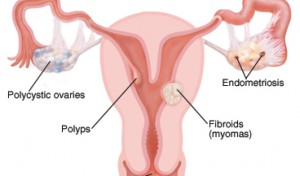 Frozen pelvis is a condition in which there are adhesions of all the organs in a female’s pelvic region especially her reproductive organs including the intestines.
Frozen pelvis is a condition in which there are adhesions of all the organs in a female’s pelvic region especially her reproductive organs including the intestines.
Adhesions are nothing but bands of scar tissue. This scar tissue develops between two organs and causes the two organ’s surfaces to stick together. This scar tissue is formed after an injury, inflammation, or disease that affects the pelvis.
Frozen Pelvis is caused by
- The adhesions in the pelvis can be caused after surgery. They may start to form a few hours after any abdominal surgical procedure.
- Endometriosis is the commonest cause. Endometriosis is a condition where the tissue that normally lines the inside of our uterus is found outside the uterus – either on the ovaries, the tissue lining the pelvis, or even the intestines.
- Pelvic inflammatory diseases can also cause adhesions in the pelvis
- Ashermann’s syndrome: Surgeries inside the uterine cavity like dilatation and curettage, or myomectomy may lead to scar tissue formation
Endometriosis frozen pelvis symptoms
• Menstrual cramps
• Pain during sexual intercourse
• Abdominal or pelvic pain and tenderness
• Lower backache
• Pain or discomfort during passing stools
Diagnosis of the frozen pelvis can be done by
A detailed case taking and pelvic examination may suggest the diagnosis of pelvic adhesions. However, in order to confirm the diagnosis laparoscopy and hysteroscopy is the best option. These are investigations in which an instrument is passed through a keyhole in the abdomen or womb.
Complications of the frozen pelvis may be
- Infertility: Pelvic adhesions commonly form around or at the end of the fallopian tube which prevents the meeting of the female egg and male sperm. The fallopian tube is a tube along which the female egg travels from the ovaries to the uterus.
- Ectopic pregnancy: If the fallopian tubes are only partially blocked by adhesions, the sperm can meet the egg for fertilization; but it may then get trapped in the tube itself resulting in a pregnancy where the fetus may develop in the tube itself.
- Disturbed ovulation: If the adhesions are formed around the ovary it may disrupt or hamper ovulation.
Frozen Pelvis Treatment includes
Surgery is the primary treatment suggested to remove pelvic adhesions. Laparoscopy and hysteroscopy give you the best possible results with minimal scarring and avoid long post-surgery admission to the hospital.
Pelvic adhesions can be prevented by
- The application of adhesion bands during surgery can help prevent pelvic adhesions
- Laparoscopy reduces the chances of adhesion formation rather than open surgery
- Incidence of pelvic adhesions is reduced by using Surgical humidification therapy
- Preventive measures like handling the pelvic organs gently, using latex-free gloves, and above all minimizing the surgery time can prevent the formation of pelvic adhesions.




